IT Strategy & Management for Royal Adelaide Hospital Report
VerifiedAdded on 2020/04/21
|30
|5051
|52
Report
AI Summary
This report provides a detailed analysis of the IT strategy and management implemented at the Royal Adelaide Hospital (RAH). It begins with an executive summary and an introduction, followed by an overview of the stakeholders and the business situation, which is assessed using PEST and SWOT analyses. The report identifies the business needs and priorities of RAH and examines its organizational structure and capabilities. It then delves into the business and IT challenges faced by the hospital, along with the associated risks and approaches used to mitigate them. The report also covers the IT infrastructure, information systems, enterprise architecture, budgeting, and the role of the CIO. Furthermore, it presents the IT strategy, justification, and a roadmap for the hospital. The report emphasizes the importance of IT in enhancing business operations, addressing challenges like shadow IT, data privacy, and inadequate data storage, and mitigating risks through effective planning, design, and implementation. The document highlights the benefits of data and digital strategies for RAH.
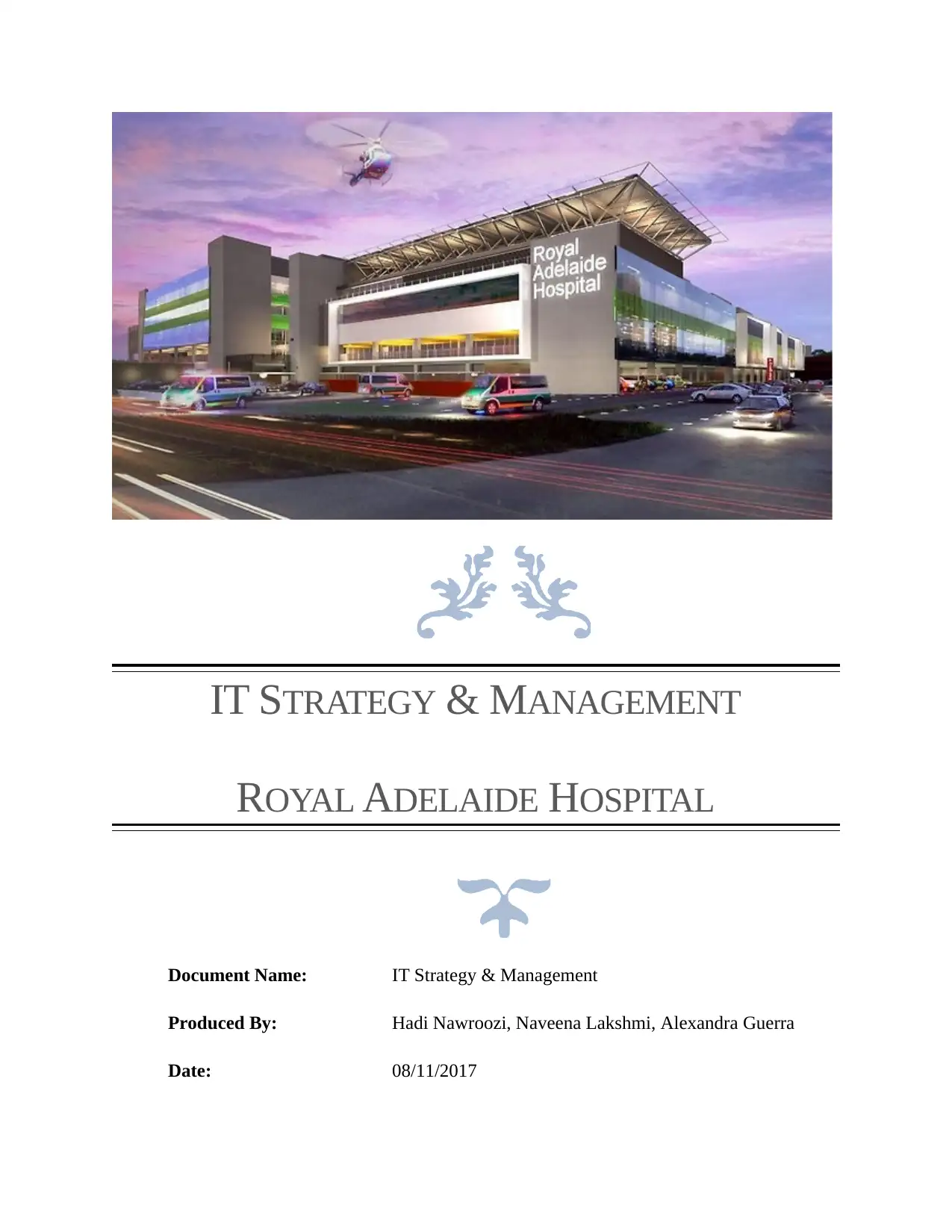
IT STRATEGY & MANAGEMENT
ROYAL ADELAIDE HOSPITAL
Document Name: IT Strategy & Management
Produced By: Hadi Nawroozi, Naveena Lakshmi, Alexandra Guerra
Date: 08/11/2017
ROYAL ADELAIDE HOSPITAL
Document Name: IT Strategy & Management
Produced By: Hadi Nawroozi, Naveena Lakshmi, Alexandra Guerra
Date: 08/11/2017
Paraphrase This Document
Need a fresh take? Get an instant paraphrase of this document with our AI Paraphraser
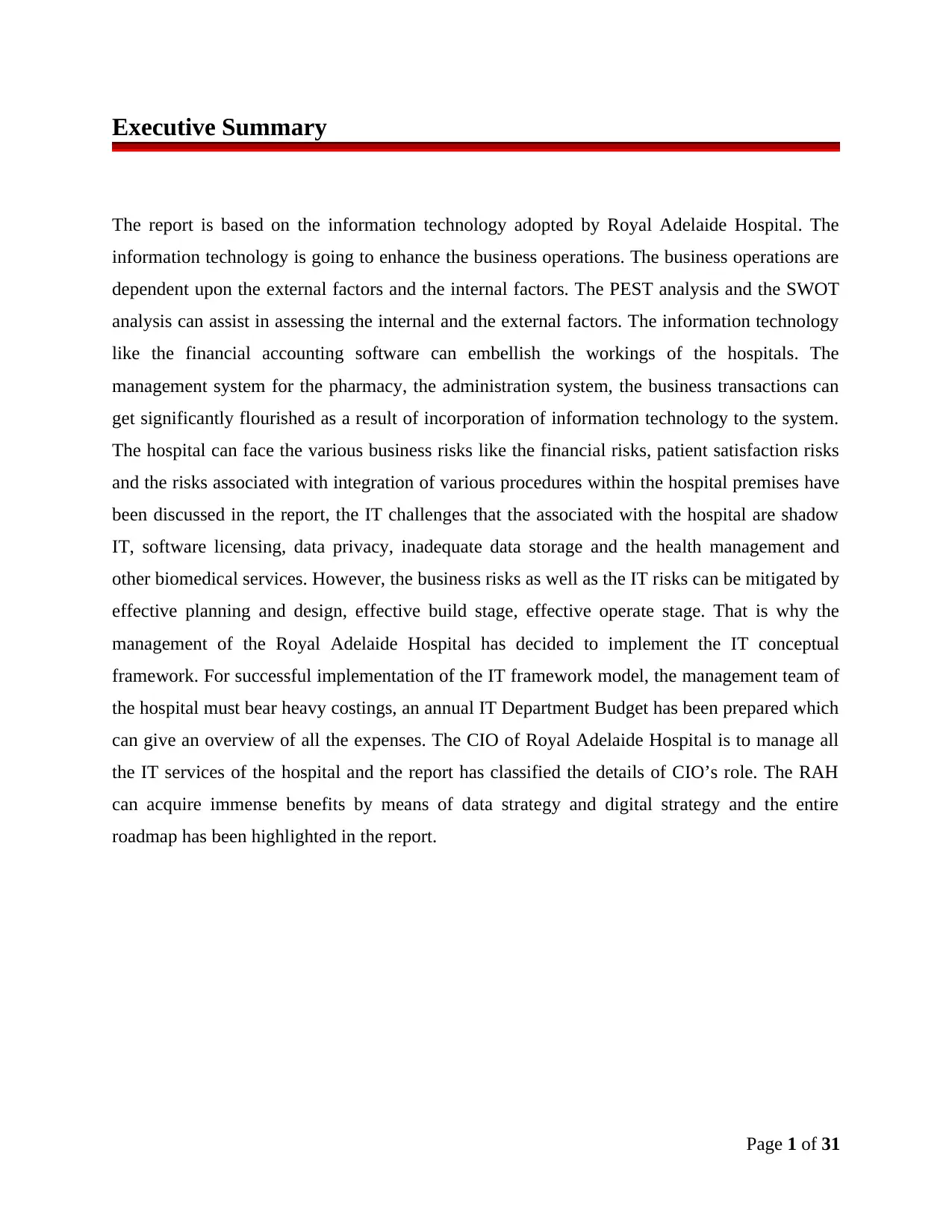
Executive Summary
The report is based on the information technology adopted by Royal Adelaide Hospital. The
information technology is going to enhance the business operations. The business operations are
dependent upon the external factors and the internal factors. The PEST analysis and the SWOT
analysis can assist in assessing the internal and the external factors. The information technology
like the financial accounting software can embellish the workings of the hospitals. The
management system for the pharmacy, the administration system, the business transactions can
get significantly flourished as a result of incorporation of information technology to the system.
The hospital can face the various business risks like the financial risks, patient satisfaction risks
and the risks associated with integration of various procedures within the hospital premises have
been discussed in the report, the IT challenges that the associated with the hospital are shadow
IT, software licensing, data privacy, inadequate data storage and the health management and
other biomedical services. However, the business risks as well as the IT risks can be mitigated by
effective planning and design, effective build stage, effective operate stage. That is why the
management of the Royal Adelaide Hospital has decided to implement the IT conceptual
framework. For successful implementation of the IT framework model, the management team of
the hospital must bear heavy costings, an annual IT Department Budget has been prepared which
can give an overview of all the expenses. The CIO of Royal Adelaide Hospital is to manage all
the IT services of the hospital and the report has classified the details of CIO’s role. The RAH
can acquire immense benefits by means of data strategy and digital strategy and the entire
roadmap has been highlighted in the report.
Page 1 of 31
The report is based on the information technology adopted by Royal Adelaide Hospital. The
information technology is going to enhance the business operations. The business operations are
dependent upon the external factors and the internal factors. The PEST analysis and the SWOT
analysis can assist in assessing the internal and the external factors. The information technology
like the financial accounting software can embellish the workings of the hospitals. The
management system for the pharmacy, the administration system, the business transactions can
get significantly flourished as a result of incorporation of information technology to the system.
The hospital can face the various business risks like the financial risks, patient satisfaction risks
and the risks associated with integration of various procedures within the hospital premises have
been discussed in the report, the IT challenges that the associated with the hospital are shadow
IT, software licensing, data privacy, inadequate data storage and the health management and
other biomedical services. However, the business risks as well as the IT risks can be mitigated by
effective planning and design, effective build stage, effective operate stage. That is why the
management of the Royal Adelaide Hospital has decided to implement the IT conceptual
framework. For successful implementation of the IT framework model, the management team of
the hospital must bear heavy costings, an annual IT Department Budget has been prepared which
can give an overview of all the expenses. The CIO of Royal Adelaide Hospital is to manage all
the IT services of the hospital and the report has classified the details of CIO’s role. The RAH
can acquire immense benefits by means of data strategy and digital strategy and the entire
roadmap has been highlighted in the report.
Page 1 of 31
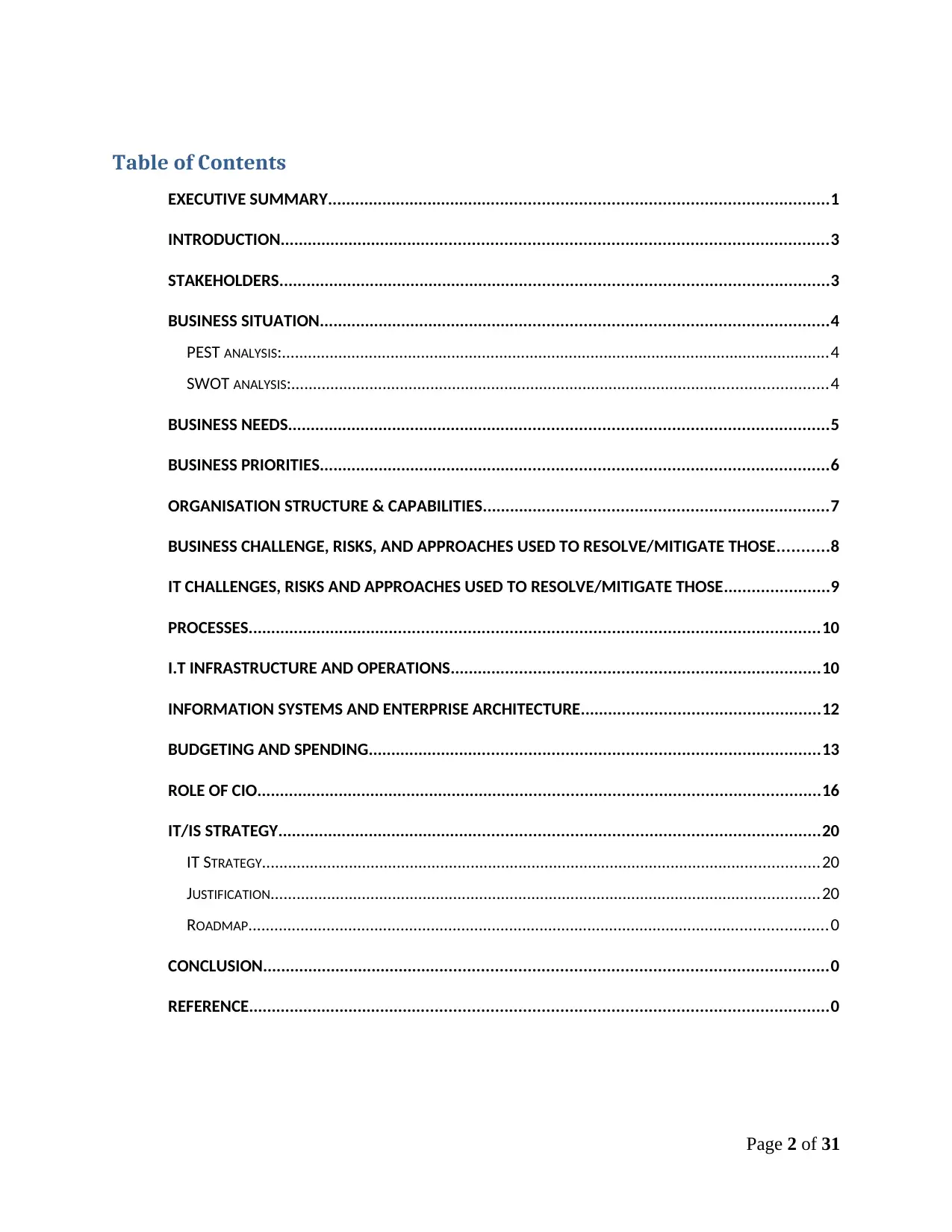
Table of Contents
EXECUTIVE SUMMARY.............................................................................................................1
INTRODUCTION.......................................................................................................................3
STAKEHOLDERS........................................................................................................................3
BUSINESS SITUATION...............................................................................................................4
PEST ANALYSIS:..............................................................................................................................4
SWOT ANALYSIS:...........................................................................................................................4
BUSINESS NEEDS......................................................................................................................5
BUSINESS PRIORITIES...............................................................................................................6
ORGANISATION STRUCTURE & CAPABILITIES...........................................................................7
BUSINESS CHALLENGE, RISKS, AND APPROACHES USED TO RESOLVE/MITIGATE THOSE...........8
IT CHALLENGES, RISKS AND APPROACHES USED TO RESOLVE/MITIGATE THOSE.......................9
PROCESSES............................................................................................................................10
I.T INFRASTRUCTURE AND OPERATIONS................................................................................10
INFORMATION SYSTEMS AND ENTERPRISE ARCHITECTURE....................................................12
BUDGETING AND SPENDING..................................................................................................13
ROLE OF CIO...........................................................................................................................16
IT/IS STRATEGY......................................................................................................................20
IT STRATEGY................................................................................................................................20
JUSTIFICATION..............................................................................................................................20
ROADMAP.....................................................................................................................................0
CONCLUSION...........................................................................................................................0
REFERENCE..............................................................................................................................0
Page 2 of 31
EXECUTIVE SUMMARY.............................................................................................................1
INTRODUCTION.......................................................................................................................3
STAKEHOLDERS........................................................................................................................3
BUSINESS SITUATION...............................................................................................................4
PEST ANALYSIS:..............................................................................................................................4
SWOT ANALYSIS:...........................................................................................................................4
BUSINESS NEEDS......................................................................................................................5
BUSINESS PRIORITIES...............................................................................................................6
ORGANISATION STRUCTURE & CAPABILITIES...........................................................................7
BUSINESS CHALLENGE, RISKS, AND APPROACHES USED TO RESOLVE/MITIGATE THOSE...........8
IT CHALLENGES, RISKS AND APPROACHES USED TO RESOLVE/MITIGATE THOSE.......................9
PROCESSES............................................................................................................................10
I.T INFRASTRUCTURE AND OPERATIONS................................................................................10
INFORMATION SYSTEMS AND ENTERPRISE ARCHITECTURE....................................................12
BUDGETING AND SPENDING..................................................................................................13
ROLE OF CIO...........................................................................................................................16
IT/IS STRATEGY......................................................................................................................20
IT STRATEGY................................................................................................................................20
JUSTIFICATION..............................................................................................................................20
ROADMAP.....................................................................................................................................0
CONCLUSION...........................................................................................................................0
REFERENCE..............................................................................................................................0
Page 2 of 31
⊘ This is a preview!⊘
Do you want full access?
Subscribe today to unlock all pages.

Trusted by 1+ million students worldwide
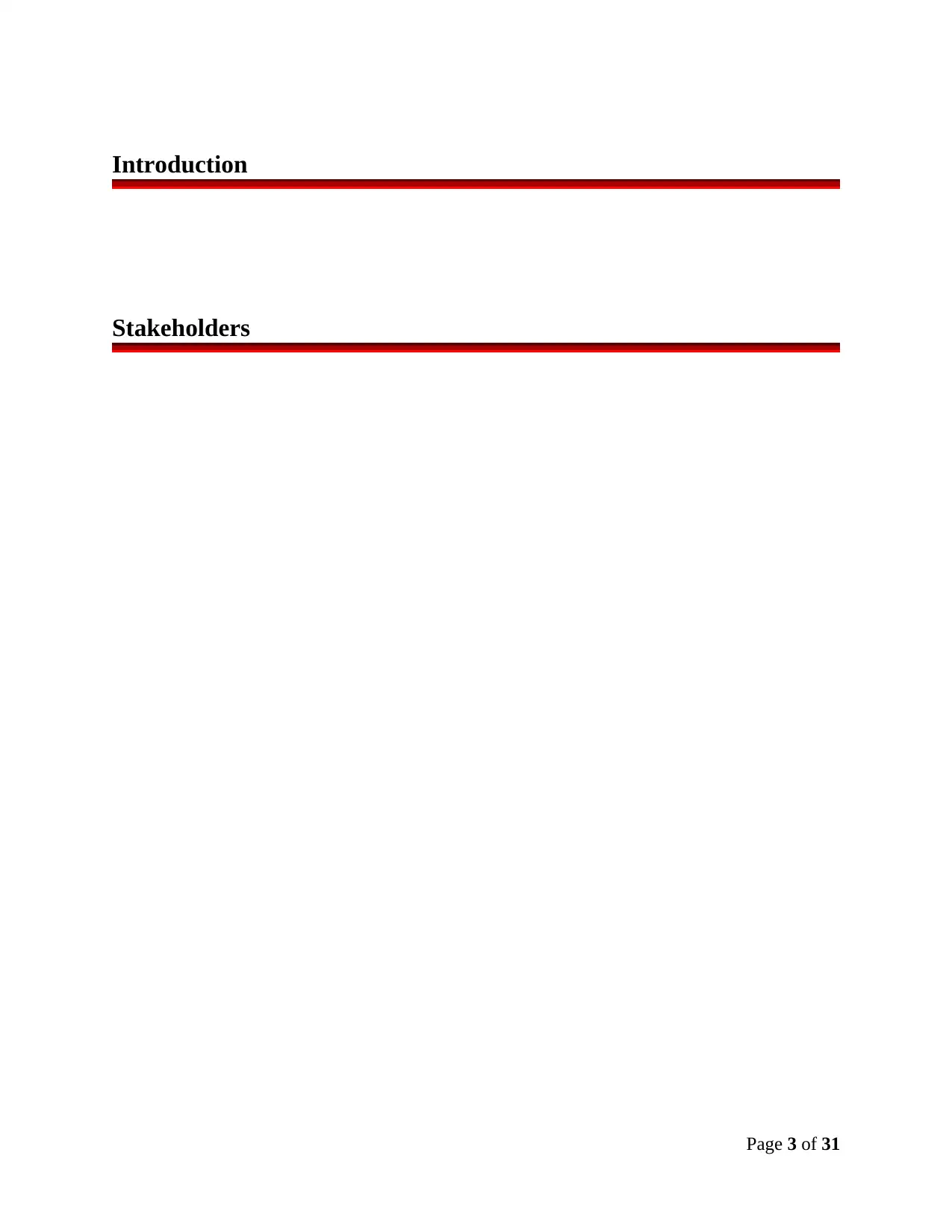
Introduction
Stakeholders
Page 3 of 31
Stakeholders
Page 3 of 31
Paraphrase This Document
Need a fresh take? Get an instant paraphrase of this document with our AI Paraphraser
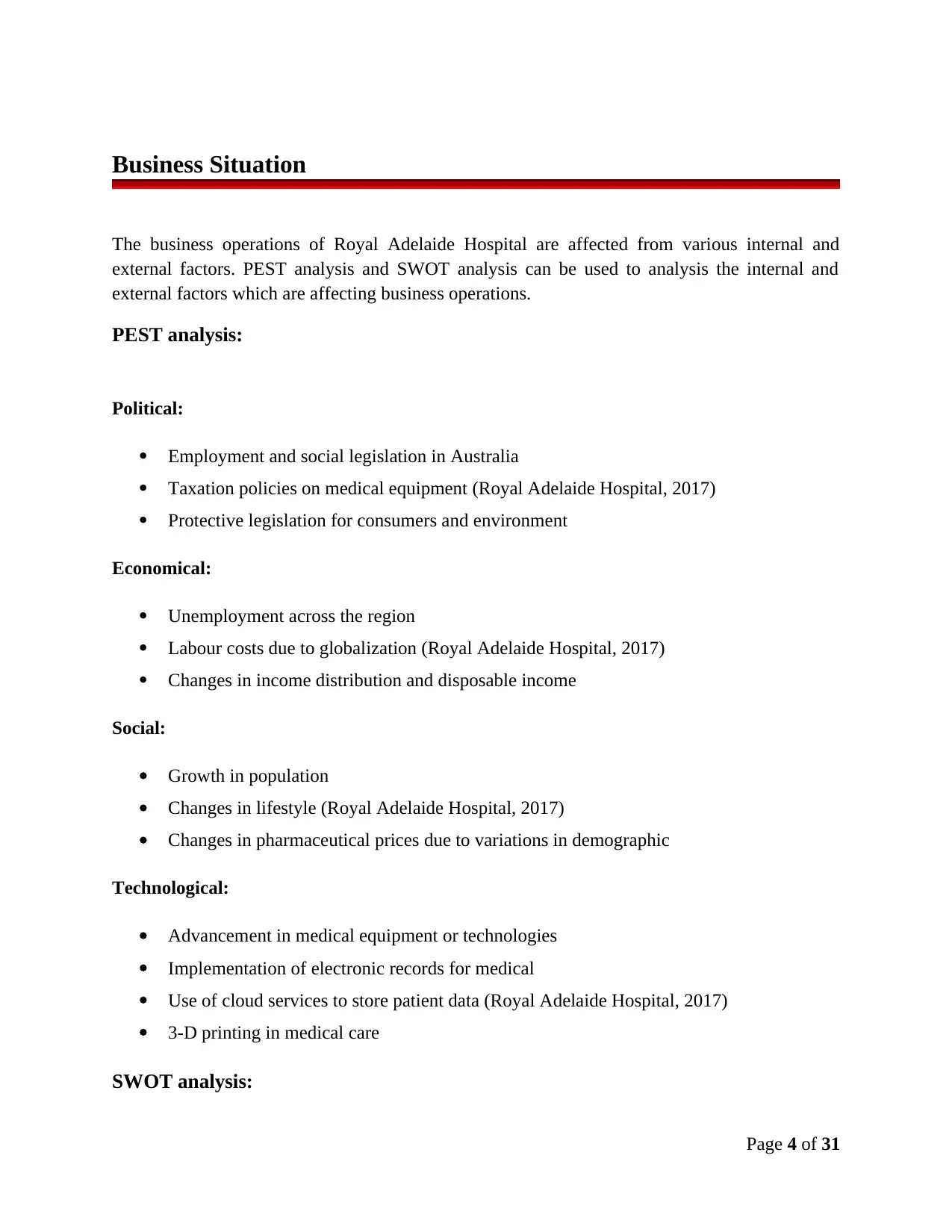
Business Situation
The business operations of Royal Adelaide Hospital are affected from various internal and
external factors. PEST analysis and SWOT analysis can be used to analysis the internal and
external factors which are affecting business operations.
PEST analysis:
Political:
Employment and social legislation in Australia
Taxation policies on medical equipment (Royal Adelaide Hospital, 2017)
Protective legislation for consumers and environment
Economical:
Unemployment across the region
Labour costs due to globalization (Royal Adelaide Hospital, 2017)
Changes in income distribution and disposable income
Social:
Growth in population
Changes in lifestyle (Royal Adelaide Hospital, 2017)
Changes in pharmaceutical prices due to variations in demographic
Technological:
Advancement in medical equipment or technologies
Implementation of electronic records for medical
Use of cloud services to store patient data (Royal Adelaide Hospital, 2017)
3-D printing in medical care
SWOT analysis:
Page 4 of 31
The business operations of Royal Adelaide Hospital are affected from various internal and
external factors. PEST analysis and SWOT analysis can be used to analysis the internal and
external factors which are affecting business operations.
PEST analysis:
Political:
Employment and social legislation in Australia
Taxation policies on medical equipment (Royal Adelaide Hospital, 2017)
Protective legislation for consumers and environment
Economical:
Unemployment across the region
Labour costs due to globalization (Royal Adelaide Hospital, 2017)
Changes in income distribution and disposable income
Social:
Growth in population
Changes in lifestyle (Royal Adelaide Hospital, 2017)
Changes in pharmaceutical prices due to variations in demographic
Technological:
Advancement in medical equipment or technologies
Implementation of electronic records for medical
Use of cloud services to store patient data (Royal Adelaide Hospital, 2017)
3-D printing in medical care
SWOT analysis:
Page 4 of 31
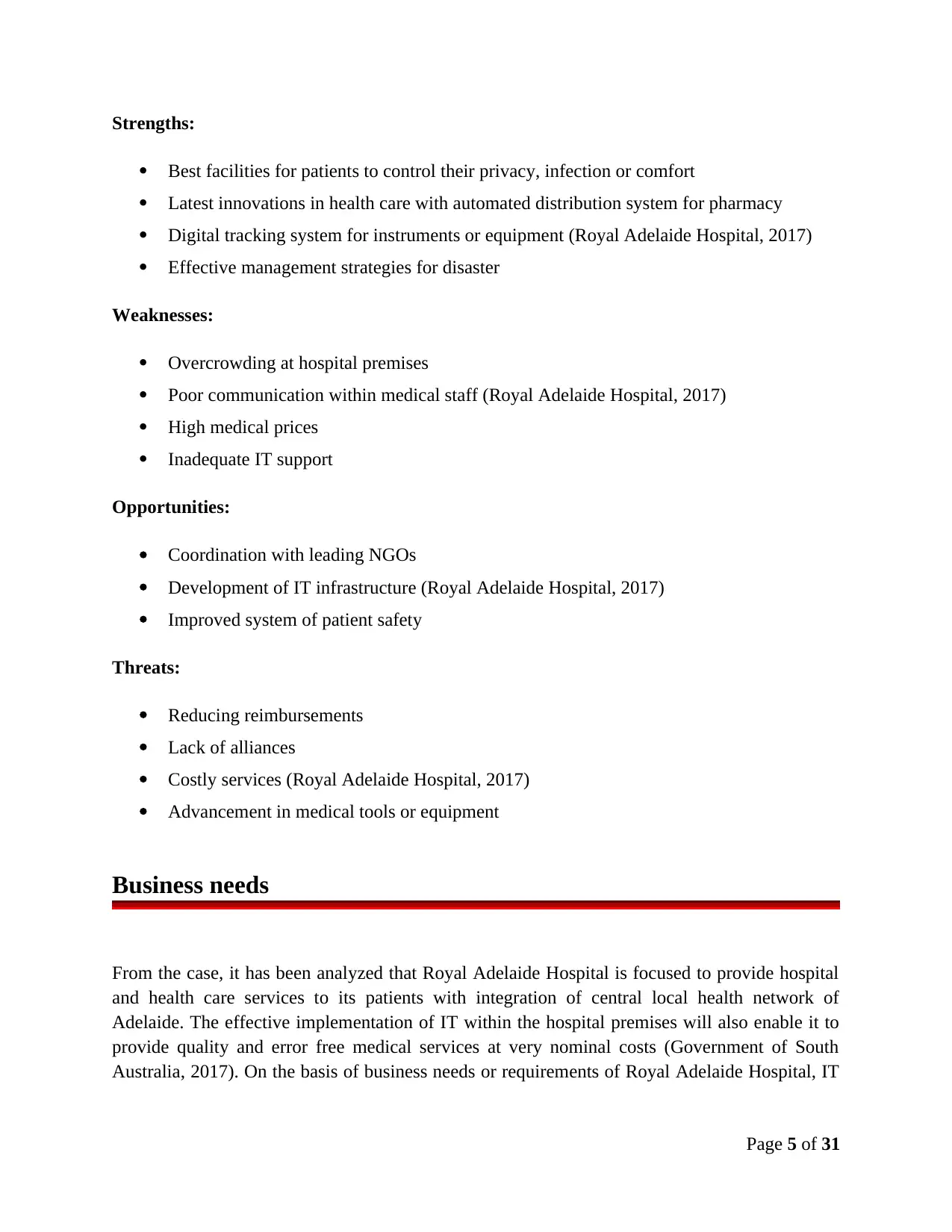
Strengths:
Best facilities for patients to control their privacy, infection or comfort
Latest innovations in health care with automated distribution system for pharmacy
Digital tracking system for instruments or equipment (Royal Adelaide Hospital, 2017)
Effective management strategies for disaster
Weaknesses:
Overcrowding at hospital premises
Poor communication within medical staff (Royal Adelaide Hospital, 2017)
High medical prices
Inadequate IT support
Opportunities:
Coordination with leading NGOs
Development of IT infrastructure (Royal Adelaide Hospital, 2017)
Improved system of patient safety
Threats:
Reducing reimbursements
Lack of alliances
Costly services (Royal Adelaide Hospital, 2017)
Advancement in medical tools or equipment
Business needs
From the case, it has been analyzed that Royal Adelaide Hospital is focused to provide hospital
and health care services to its patients with integration of central local health network of
Adelaide. The effective implementation of IT within the hospital premises will also enable it to
provide quality and error free medical services at very nominal costs (Government of South
Australia, 2017). On the basis of business needs or requirements of Royal Adelaide Hospital, IT
Page 5 of 31
Best facilities for patients to control their privacy, infection or comfort
Latest innovations in health care with automated distribution system for pharmacy
Digital tracking system for instruments or equipment (Royal Adelaide Hospital, 2017)
Effective management strategies for disaster
Weaknesses:
Overcrowding at hospital premises
Poor communication within medical staff (Royal Adelaide Hospital, 2017)
High medical prices
Inadequate IT support
Opportunities:
Coordination with leading NGOs
Development of IT infrastructure (Royal Adelaide Hospital, 2017)
Improved system of patient safety
Threats:
Reducing reimbursements
Lack of alliances
Costly services (Royal Adelaide Hospital, 2017)
Advancement in medical tools or equipment
Business needs
From the case, it has been analyzed that Royal Adelaide Hospital is focused to provide hospital
and health care services to its patients with integration of central local health network of
Adelaide. The effective implementation of IT within the hospital premises will also enable it to
provide quality and error free medical services at very nominal costs (Government of South
Australia, 2017). On the basis of business needs or requirements of Royal Adelaide Hospital, IT
Page 5 of 31
⊘ This is a preview!⊘
Do you want full access?
Subscribe today to unlock all pages.

Trusted by 1+ million students worldwide
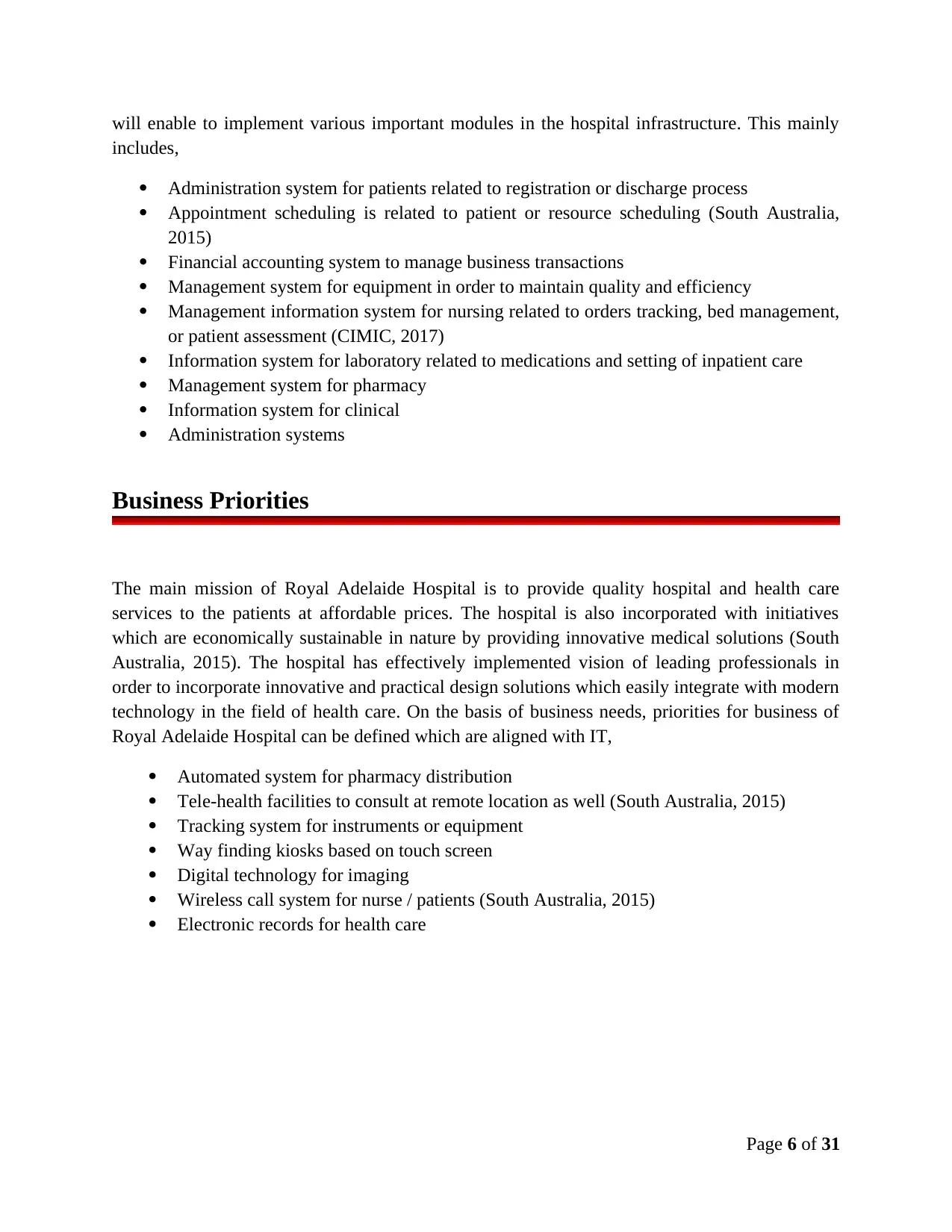
will enable to implement various important modules in the hospital infrastructure. This mainly
includes,
Administration system for patients related to registration or discharge process
Appointment scheduling is related to patient or resource scheduling (South Australia,
2015)
Financial accounting system to manage business transactions
Management system for equipment in order to maintain quality and efficiency
Management information system for nursing related to orders tracking, bed management,
or patient assessment (CIMIC, 2017)
Information system for laboratory related to medications and setting of inpatient care
Management system for pharmacy
Information system for clinical
Administration systems
Business Priorities
The main mission of Royal Adelaide Hospital is to provide quality hospital and health care
services to the patients at affordable prices. The hospital is also incorporated with initiatives
which are economically sustainable in nature by providing innovative medical solutions (South
Australia, 2015). The hospital has effectively implemented vision of leading professionals in
order to incorporate innovative and practical design solutions which easily integrate with modern
technology in the field of health care. On the basis of business needs, priorities for business of
Royal Adelaide Hospital can be defined which are aligned with IT,
Automated system for pharmacy distribution
Tele-health facilities to consult at remote location as well (South Australia, 2015)
Tracking system for instruments or equipment
Way finding kiosks based on touch screen
Digital technology for imaging
Wireless call system for nurse / patients (South Australia, 2015)
Electronic records for health care
Page 6 of 31
includes,
Administration system for patients related to registration or discharge process
Appointment scheduling is related to patient or resource scheduling (South Australia,
2015)
Financial accounting system to manage business transactions
Management system for equipment in order to maintain quality and efficiency
Management information system for nursing related to orders tracking, bed management,
or patient assessment (CIMIC, 2017)
Information system for laboratory related to medications and setting of inpatient care
Management system for pharmacy
Information system for clinical
Administration systems
Business Priorities
The main mission of Royal Adelaide Hospital is to provide quality hospital and health care
services to the patients at affordable prices. The hospital is also incorporated with initiatives
which are economically sustainable in nature by providing innovative medical solutions (South
Australia, 2015). The hospital has effectively implemented vision of leading professionals in
order to incorporate innovative and practical design solutions which easily integrate with modern
technology in the field of health care. On the basis of business needs, priorities for business of
Royal Adelaide Hospital can be defined which are aligned with IT,
Automated system for pharmacy distribution
Tele-health facilities to consult at remote location as well (South Australia, 2015)
Tracking system for instruments or equipment
Way finding kiosks based on touch screen
Digital technology for imaging
Wireless call system for nurse / patients (South Australia, 2015)
Electronic records for health care
Page 6 of 31
Paraphrase This Document
Need a fresh take? Get an instant paraphrase of this document with our AI Paraphraser
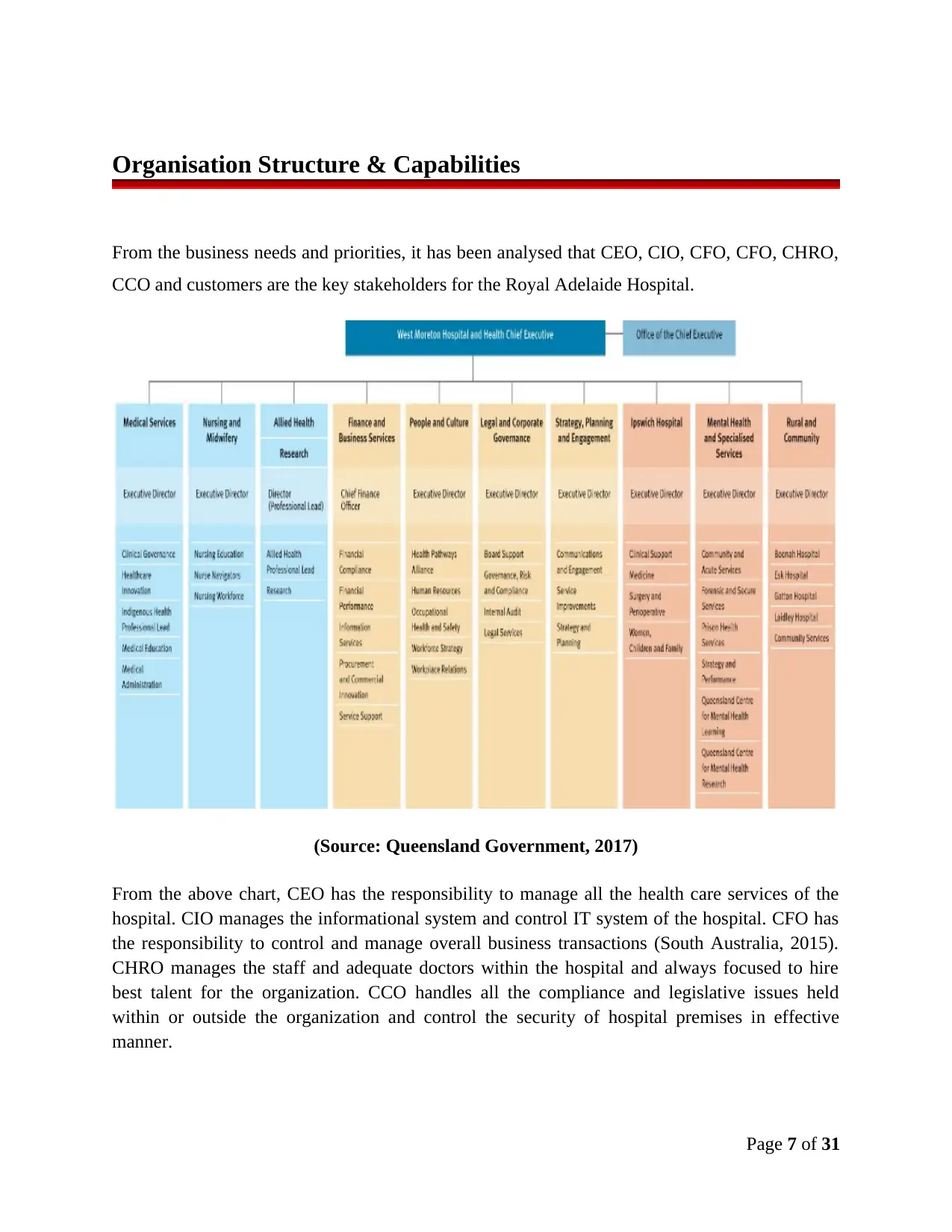
Organisation Structure & Capabilities
From the business needs and priorities, it has been analysed that CEO, CIO, CFO, CFO, CHRO,
CCO and customers are the key stakeholders for the Royal Adelaide Hospital.
(Source: Queensland Government, 2017)
From the above chart, CEO has the responsibility to manage all the health care services of the
hospital. CIO manages the informational system and control IT system of the hospital. CFO has
the responsibility to control and manage overall business transactions (South Australia, 2015).
CHRO manages the staff and adequate doctors within the hospital and always focused to hire
best talent for the organization. CCO handles all the compliance and legislative issues held
within or outside the organization and control the security of hospital premises in effective
manner.
Page 7 of 31
From the business needs and priorities, it has been analysed that CEO, CIO, CFO, CFO, CHRO,
CCO and customers are the key stakeholders for the Royal Adelaide Hospital.
(Source: Queensland Government, 2017)
From the above chart, CEO has the responsibility to manage all the health care services of the
hospital. CIO manages the informational system and control IT system of the hospital. CFO has
the responsibility to control and manage overall business transactions (South Australia, 2015).
CHRO manages the staff and adequate doctors within the hospital and always focused to hire
best talent for the organization. CCO handles all the compliance and legislative issues held
within or outside the organization and control the security of hospital premises in effective
manner.
Page 7 of 31
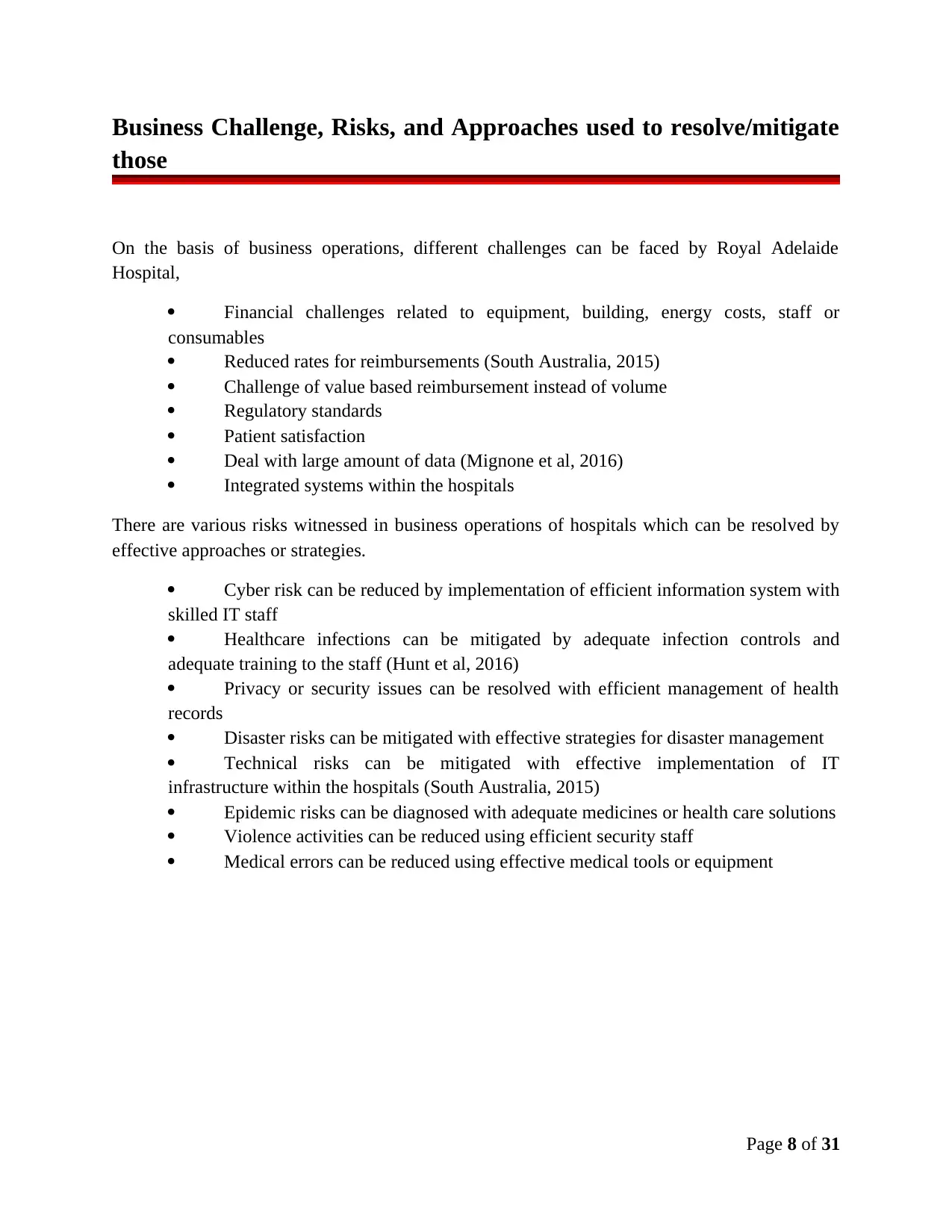
Business Challenge, Risks, and Approaches used to resolve/mitigate
those
On the basis of business operations, different challenges can be faced by Royal Adelaide
Hospital,
Financial challenges related to equipment, building, energy costs, staff or
consumables
Reduced rates for reimbursements (South Australia, 2015)
Challenge of value based reimbursement instead of volume
Regulatory standards
Patient satisfaction
Deal with large amount of data (Mignone et al, 2016)
Integrated systems within the hospitals
There are various risks witnessed in business operations of hospitals which can be resolved by
effective approaches or strategies.
Cyber risk can be reduced by implementation of efficient information system with
skilled IT staff
Healthcare infections can be mitigated by adequate infection controls and
adequate training to the staff (Hunt et al, 2016)
Privacy or security issues can be resolved with efficient management of health
records
Disaster risks can be mitigated with effective strategies for disaster management
Technical risks can be mitigated with effective implementation of IT
infrastructure within the hospitals (South Australia, 2015)
Epidemic risks can be diagnosed with adequate medicines or health care solutions
Violence activities can be reduced using efficient security staff
Medical errors can be reduced using effective medical tools or equipment
Page 8 of 31
those
On the basis of business operations, different challenges can be faced by Royal Adelaide
Hospital,
Financial challenges related to equipment, building, energy costs, staff or
consumables
Reduced rates for reimbursements (South Australia, 2015)
Challenge of value based reimbursement instead of volume
Regulatory standards
Patient satisfaction
Deal with large amount of data (Mignone et al, 2016)
Integrated systems within the hospitals
There are various risks witnessed in business operations of hospitals which can be resolved by
effective approaches or strategies.
Cyber risk can be reduced by implementation of efficient information system with
skilled IT staff
Healthcare infections can be mitigated by adequate infection controls and
adequate training to the staff (Hunt et al, 2016)
Privacy or security issues can be resolved with efficient management of health
records
Disaster risks can be mitigated with effective strategies for disaster management
Technical risks can be mitigated with effective implementation of IT
infrastructure within the hospitals (South Australia, 2015)
Epidemic risks can be diagnosed with adequate medicines or health care solutions
Violence activities can be reduced using efficient security staff
Medical errors can be reduced using effective medical tools or equipment
Page 8 of 31
⊘ This is a preview!⊘
Do you want full access?
Subscribe today to unlock all pages.

Trusted by 1+ million students worldwide
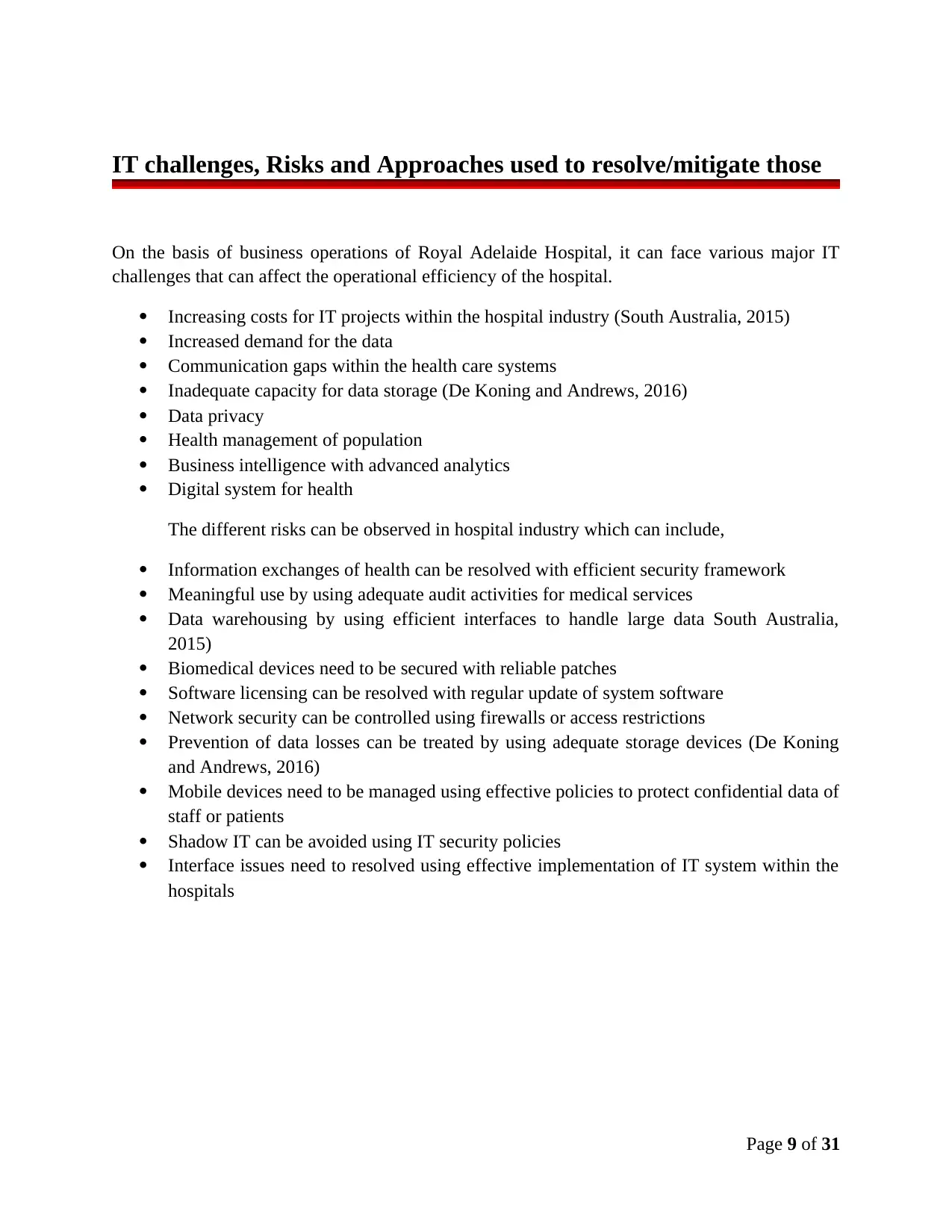
IT challenges, Risks and Approaches used to resolve/mitigate those
On the basis of business operations of Royal Adelaide Hospital, it can face various major IT
challenges that can affect the operational efficiency of the hospital.
Increasing costs for IT projects within the hospital industry (South Australia, 2015)
Increased demand for the data
Communication gaps within the health care systems
Inadequate capacity for data storage (De Koning and Andrews, 2016)
Data privacy
Health management of population
Business intelligence with advanced analytics
Digital system for health
The different risks can be observed in hospital industry which can include,
Information exchanges of health can be resolved with efficient security framework
Meaningful use by using adequate audit activities for medical services
Data warehousing by using efficient interfaces to handle large data South Australia,
2015)
Biomedical devices need to be secured with reliable patches
Software licensing can be resolved with regular update of system software
Network security can be controlled using firewalls or access restrictions
Prevention of data losses can be treated by using adequate storage devices (De Koning
and Andrews, 2016)
Mobile devices need to be managed using effective policies to protect confidential data of
staff or patients
Shadow IT can be avoided using IT security policies
Interface issues need to resolved using effective implementation of IT system within the
hospitals
Page 9 of 31
On the basis of business operations of Royal Adelaide Hospital, it can face various major IT
challenges that can affect the operational efficiency of the hospital.
Increasing costs for IT projects within the hospital industry (South Australia, 2015)
Increased demand for the data
Communication gaps within the health care systems
Inadequate capacity for data storage (De Koning and Andrews, 2016)
Data privacy
Health management of population
Business intelligence with advanced analytics
Digital system for health
The different risks can be observed in hospital industry which can include,
Information exchanges of health can be resolved with efficient security framework
Meaningful use by using adequate audit activities for medical services
Data warehousing by using efficient interfaces to handle large data South Australia,
2015)
Biomedical devices need to be secured with reliable patches
Software licensing can be resolved with regular update of system software
Network security can be controlled using firewalls or access restrictions
Prevention of data losses can be treated by using adequate storage devices (De Koning
and Andrews, 2016)
Mobile devices need to be managed using effective policies to protect confidential data of
staff or patients
Shadow IT can be avoided using IT security policies
Interface issues need to resolved using effective implementation of IT system within the
hospitals
Page 9 of 31
Paraphrase This Document
Need a fresh take? Get an instant paraphrase of this document with our AI Paraphraser
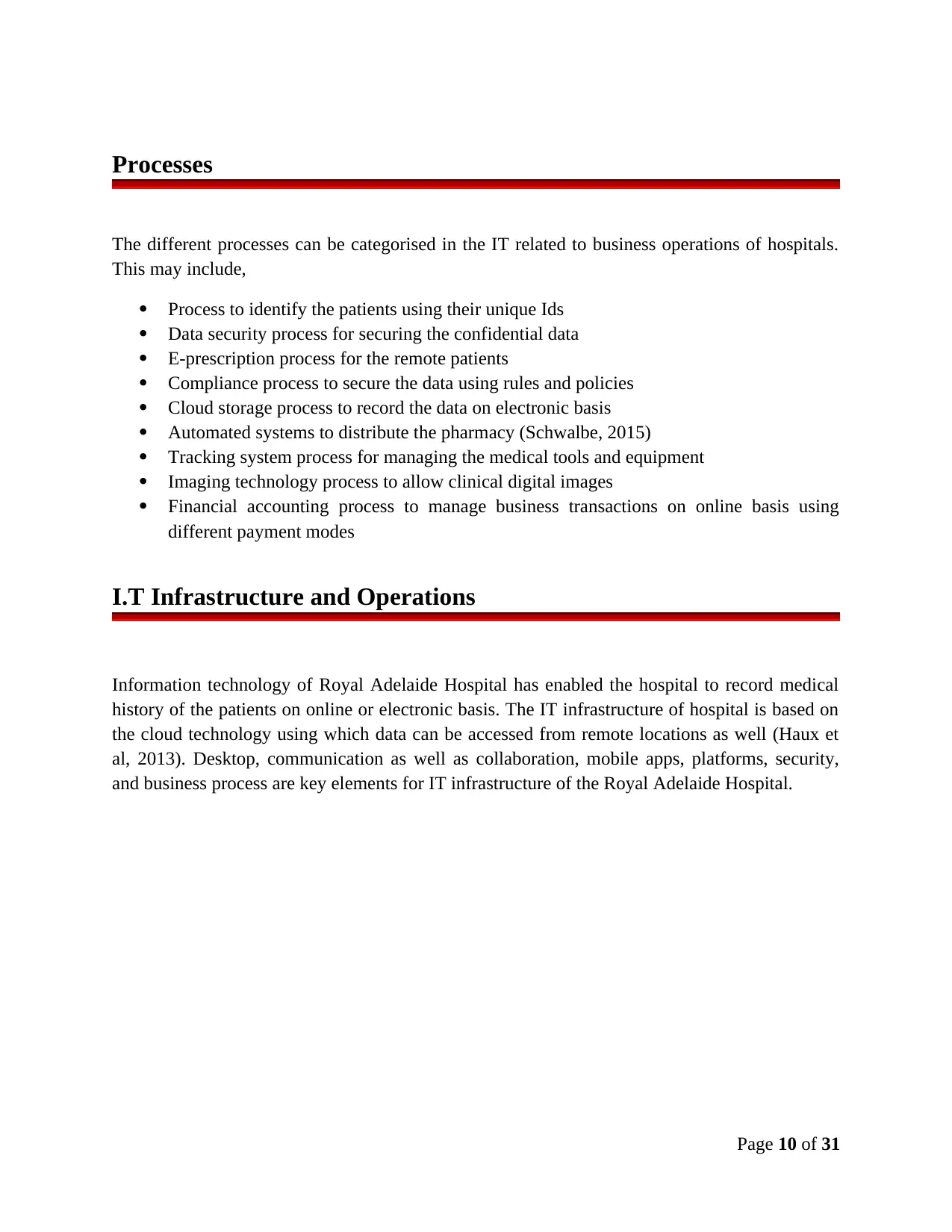
Processes
The different processes can be categorised in the IT related to business operations of hospitals.
This may include,
Process to identify the patients using their unique Ids
Data security process for securing the confidential data
E-prescription process for the remote patients
Compliance process to secure the data using rules and policies
Cloud storage process to record the data on electronic basis
Automated systems to distribute the pharmacy (Schwalbe, 2015)
Tracking system process for managing the medical tools and equipment
Imaging technology process to allow clinical digital images
Financial accounting process to manage business transactions on online basis using
different payment modes
I.T Infrastructure and Operations
Information technology of Royal Adelaide Hospital has enabled the hospital to record medical
history of the patients on online or electronic basis. The IT infrastructure of hospital is based on
the cloud technology using which data can be accessed from remote locations as well (Haux et
al, 2013). Desktop, communication as well as collaboration, mobile apps, platforms, security,
and business process are key elements for IT infrastructure of the Royal Adelaide Hospital.
Page 10 of 31
The different processes can be categorised in the IT related to business operations of hospitals.
This may include,
Process to identify the patients using their unique Ids
Data security process for securing the confidential data
E-prescription process for the remote patients
Compliance process to secure the data using rules and policies
Cloud storage process to record the data on electronic basis
Automated systems to distribute the pharmacy (Schwalbe, 2015)
Tracking system process for managing the medical tools and equipment
Imaging technology process to allow clinical digital images
Financial accounting process to manage business transactions on online basis using
different payment modes
I.T Infrastructure and Operations
Information technology of Royal Adelaide Hospital has enabled the hospital to record medical
history of the patients on online or electronic basis. The IT infrastructure of hospital is based on
the cloud technology using which data can be accessed from remote locations as well (Haux et
al, 2013). Desktop, communication as well as collaboration, mobile apps, platforms, security,
and business process are key elements for IT infrastructure of the Royal Adelaide Hospital.
Page 10 of 31
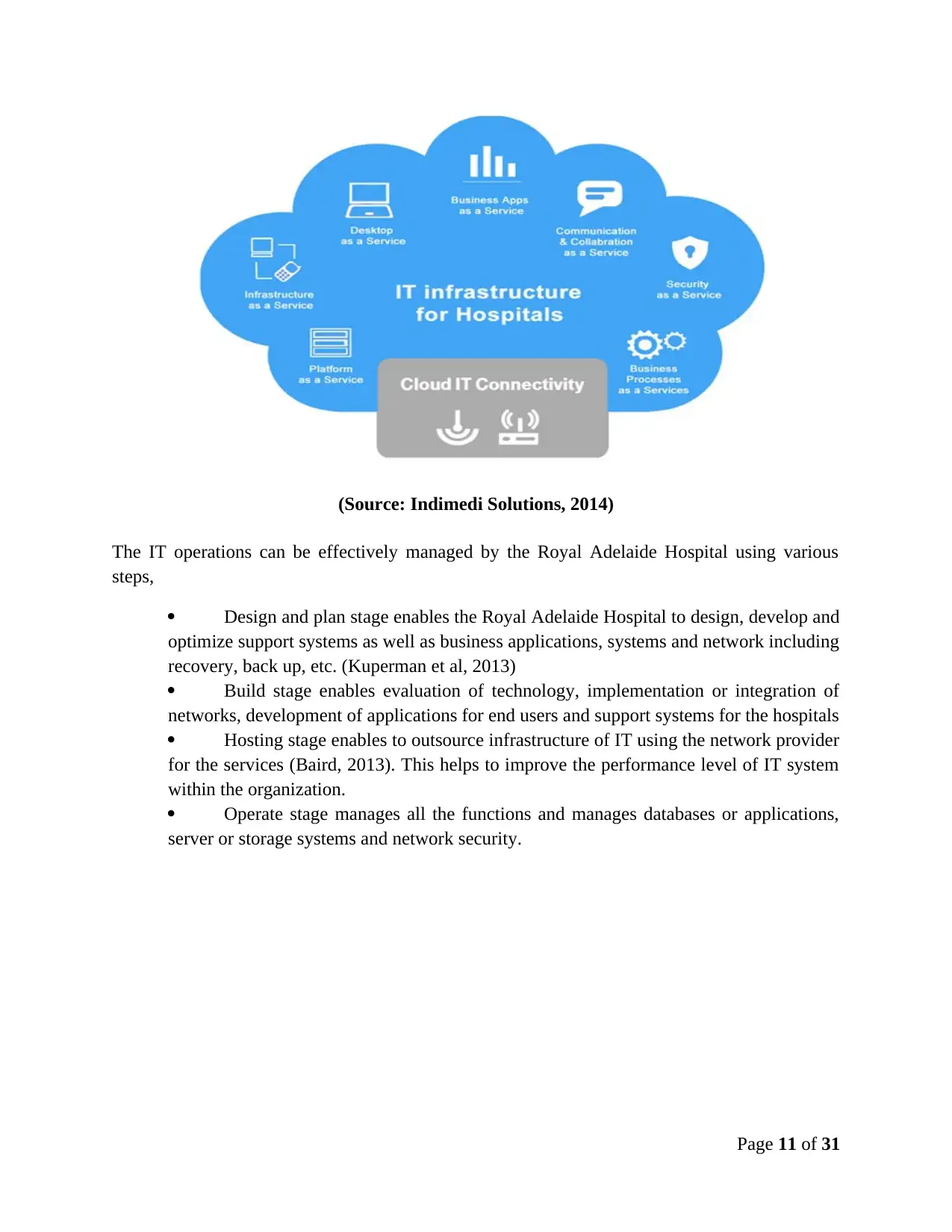
(Source: Indimedi Solutions, 2014)
The IT operations can be effectively managed by the Royal Adelaide Hospital using various
steps,
Design and plan stage enables the Royal Adelaide Hospital to design, develop and
optimize support systems as well as business applications, systems and network including
recovery, back up, etc. (Kuperman et al, 2013)
Build stage enables evaluation of technology, implementation or integration of
networks, development of applications for end users and support systems for the hospitals
Hosting stage enables to outsource infrastructure of IT using the network provider
for the services (Baird, 2013). This helps to improve the performance level of IT system
within the organization.
Operate stage manages all the functions and manages databases or applications,
server or storage systems and network security.
Page 11 of 31
The IT operations can be effectively managed by the Royal Adelaide Hospital using various
steps,
Design and plan stage enables the Royal Adelaide Hospital to design, develop and
optimize support systems as well as business applications, systems and network including
recovery, back up, etc. (Kuperman et al, 2013)
Build stage enables evaluation of technology, implementation or integration of
networks, development of applications for end users and support systems for the hospitals
Hosting stage enables to outsource infrastructure of IT using the network provider
for the services (Baird, 2013). This helps to improve the performance level of IT system
within the organization.
Operate stage manages all the functions and manages databases or applications,
server or storage systems and network security.
Page 11 of 31
⊘ This is a preview!⊘
Do you want full access?
Subscribe today to unlock all pages.

Trusted by 1+ million students worldwide
1 out of 30
Related Documents
Your All-in-One AI-Powered Toolkit for Academic Success.
+13062052269
info@desklib.com
Available 24*7 on WhatsApp / Email
![[object Object]](/_next/static/media/star-bottom.7253800d.svg)
Unlock your academic potential
Copyright © 2020–2025 A2Z Services. All Rights Reserved. Developed and managed by ZUCOL.





